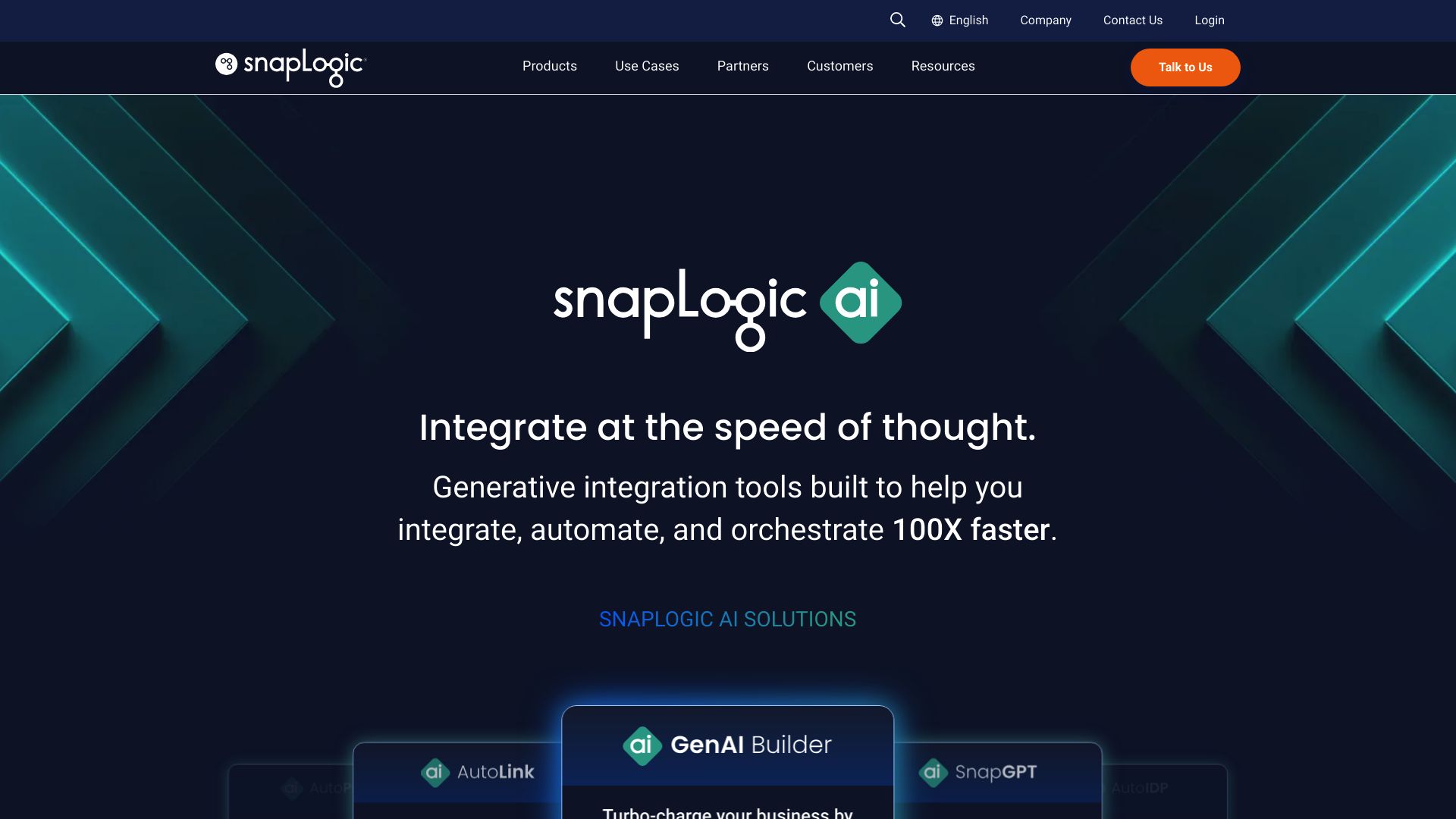snapLogic AI vs. MetaGPT: Comparing AI Agent Builders
AI-powered agent builders are transforming how businesses develop and deploy intelligent solutions. This comparison explores SmythOS, snapLogic AI vs. MetaGPT, three platforms at the forefront of this revolution. SmythOS offers a comprehensive suite for creating autonomous agents, featuring visual builders and advanced collaboration tools. snapLogic AI specializes in data integration and workflow automation, leveraging AI to streamline enterprise processes. MetaGPT takes a unique approach, simulating software development teams with AI agents. We’ll examine how each platform addresses key challenges in AI development, from ease of use to deployment flexibility, helping you determine which solution best fits your organization’s needs.
snapLogic AI Overview
snapLogic AI delivers an Intelligent Integration Platform that automates data and application integration tasks using AI-powered workflows. The platform caters to both expert developers and citizen integrators, enabling them to build, deploy, and manage integrations across on-premises, cloud, and hybrid environments.
SnapLogic’s visual interface simplifies complex integration processes through drag-and-drop functionality. Users can leverage pre-built connectors called “Snaps” to link various SaaS applications and data sources effortlessly. The platform’s AI capabilities, including Iris AI technology, offer intelligent recommendations for building data pipelines, significantly reducing the time and effort required for integration projects.
SnapLogic’s visual interface simplifies complex integration processes through drag-and-drop functionality. Users can leverage pre-built connectors called “Snaps” to link various SaaS applications and data sources effortlessly.


Key features of snapLogic AI include scalability through Amazon’s Elastic Compute Cloud, comprehensive integration support for various data types, and advanced monitoring tools. The platform also offers generative AI capabilities with SnapGPT and GenAI Builder, enabling no-code development of AI applications and chatbots using natural language prompts.
While snapLogic AI excels in enterprise-level integrations and offers robust AI-driven automation, it may present a steeper learning curve for users without technical backgrounds. The platform’s extensive feature set, while powerful, can be overwhelming for smaller organizations with simpler integration needs. Additionally, pricing information is not readily available, which may pose challenges for budget-conscious users evaluating the platform’s cost-effectiveness.
SnapLogic AI positions itself as a comprehensive solution for organizations seeking to accelerate digital transformation through AI-powered integration. Its vision focuses on simplifying enterprise system integration, democratizing data access, and enabling users to harness AI capabilities for driving innovation and business growth. As the integration landscape evolves, snapLogic AI continues to expand its offerings, aiming to stay at the forefront of AI-led integration technologies.
MetaGPT Overview
MetaGPT tackles complex software engineering tasks by simulating a collaborative team of AI agents. This open-source framework assigns specialized roles like product managers, architects, and engineers to individual agents, mirroring a real software company’s structure. MetaGPT leverages human-like Standardized Operating Procedures (SOPs) to guide agent interactions, resulting in more coherent and reliable outputs.


MetaGPT’s assembly line approach breaks down large projects into manageable subtasks. Each agent contributes its expertise, enhancing overall solution quality. The framework generates comprehensive documentation throughout the development process, including requirement documents, design artifacts, and interface specifications. This thorough approach improves code success rates and facilitates smoother human-AI collaboration.
MetaGPT’s assembly line approach breaks down large projects into manageable subtasks. Each agent contributes its expertise, enhancing overall solution quality.
Developed by researchers from prestigious institutions, MetaGPT aims to set a new standard in AI collaboration. Its unique selling point lies in its ability to closely mirror human teamwork within an AI system. By incorporating SOPs and defined roles, MetaGPT ensures AI agents work together efficiently, producing high-quality outputs aligned with human expectations.
While MetaGPT offers powerful capabilities for complex software development tasks, it may present a steeper learning curve for non-technical users. The framework’s focus on replicating software company structures could be overwhelming for those seeking simpler AI agent solutions. Additionally, as an open-source project, MetaGPT may require more hands-on configuration and maintenance compared to some commercial alternatives.
Feature Comparison
SmythOS and snapLogic AI offer robust AI agent building capabilities, but with key differences in their approaches and feature sets. SmythOS excels in its comprehensive support for autonomous agent development, providing a visual builder, no-code options, and advanced debugging tools that cater to users across technical skill levels. Its multi-agent collaboration features and human-AI interaction capabilities stand out, enabling complex problem-solving scenarios.
In contrast, snapLogic AI focuses more on data integration and workflow automation, leveraging AI to streamline these processes. While it offers strong visual building tools and supports various data types, it lacks some of the advanced AI agent features found in SmythOS, such as autonomous agents and multi-agent collaboration. snapLogic AI’s strength lies in its extensive API integrations and data processing capabilities, making it well-suited for enterprise-level data management tasks.
Both platforms offer robust security features, but SmythOS edges out with its more comprehensive approach to constrained alignment and explainable AI. SmythOS also provides more flexibility in deployment options, allowing users to deploy agents as APIs, chatbots, or scheduled tasks with greater ease. While snapLogic AI offers powerful data integration tools, SmythOS’s focus on creating versatile, intelligent agents gives it an advantage for users looking to develop more sophisticated AI solutions across various domains.
Feature Comparison Table
| snapLogic AI | MetaGPT | SmythOS | |
|---|---|---|---|
| CORE FEATURES | |||
| Visual Builder | ✅ | ❌ | ✅ |
| No-Code Options | ✅ | ❌ | ✅ |
| Memory & Context | ❌ | ✅ | ✅ |
| SECURITY | |||
| IP Control | ✅ | ❌ | ✅ |
| COMPONENTS | |||
| Foundation AIs | ❌ | ✅ | ✅ |
| Huggingface AIs | ❌ | ✅ | ✅ |
| Zapier APIs | ❌ | ✅ | ✅ |
| Classifiers | ❌ | ✅ | ✅ |
| Data Lakes | ✅ | ❌ | ✅ |
| DEPLOYMENT OPTIONS (EMBODIMENTS) | |||
| Staging Domains | ❌ | ❌ | ✅ |
| Production Domains | ❌ | ✅ | ✅ |
| Deploy as Site Chat | ❌ | ✅ | ✅ |
| Deploy as GPT | ❌ | ✅ | ✅ |
| DATA LAKE SUPPORT | |||
| Hosted Vector Database | ❌ | ❌ | ✅ |
| Sitemap Crawler | ❌ | ❌ | ✅ |
| YouTube Transcript Crawler | ❌ | ❌ | ✅ |
| URL Crawler | ❌ | ✅ | ✅ |
Best Alternative to snapLogic AI and MetaGPT
SmythOS stands out as the superior alternative to snapLogic AI and MetaGPT, offering a comprehensive platform for AI agent development and deployment. We’ve designed SmythOS to empower users with an intuitive visual builder and no-code options, making advanced AI capabilities accessible to both technical and non-technical users alike.
Our platform excels in providing a robust set of features that outpace the competition. While snapLogic AI focuses primarily on data integration and workflow automation, SmythOS offers a more versatile approach to AI agent creation. We support autonomous agents, multi-agent collaboration, and advanced problem-solving capabilities, enabling users to tackle complex tasks across various domains.
SmythOS stands out as the superior alternative to snapLogic AI and MetaGPT, offering a comprehensive platform for AI agent development and deployment.
Unlike MetaGPT, which requires coding knowledge, SmythOS democratizes AI development with our user-friendly interface. We offer a wide array of deployment options, allowing users to easily integrate AI agents into their existing systems as APIs, chatbots, or scheduled tasks. Our platform also provides superior memory and context management, ensuring that AI agents maintain coherent and contextually relevant interactions.
SmythOS sets itself apart with its extensive integration ecosystem and scalability features. We support a variety of foundation models, Hugging Face integrations, and seamless API connections, including Zapier. This flexibility ensures that our platform can adapt to virtually any workflow or business process. Additionally, our hosted vector database and advanced data lake support provide the infrastructure needed for handling large-scale AI operations, a capability not matched by snapLogic AI or MetaGPT.
By choosing SmythOS, users gain access to a cutting-edge AI platform that combines ease of use with powerful capabilities. We’ve designed our system to grow with your needs, offering unparalleled scalability and performance. Whether you’re a small business looking to automate customer interactions or an enterprise seeking to implement complex AI solutions, SmythOS provides the tools and flexibility to bring your AI vision to life efficiently and effectively.
Conclusion
SmythOS emerges as the superior choice for AI agent development and deployment. Its comprehensive feature set, including a visual builder, no-code options, and advanced debugging tools, caters to users across all technical skill levels. The platform’s multi-agent collaboration capabilities and human-AI interaction features enable complex problem-solving scenarios that surpass the offerings of snapLogic AI and MetaGPT.
While snapLogic AI excels in data integration and workflow automation, and MetaGPT offers a unique approach to simulating software development teams, both platforms fall short of SmythOS’s versatility and ease of use. SmythOS’s ability to deploy agents as APIs, chatbots, or scheduled tasks, coupled with its robust security features and flexible deployment options, gives it a significant edge in the AI agent development landscape.
For organizations seeking to harness the full potential of AI, SmythOS provides the most comprehensive and user-friendly solution. Its extensive integration ecosystem, support for various AI models, and focus on creating versatile, intelligent agents make it the ideal choice for businesses looking to innovate and automate at scale.
To experience the power of SmythOS and revolutionize your AI development process, create a free SmythOS account today. With unlimited agents and a 30-day money-back guarantee, you can explore the platform’s capabilities risk-free. For those seeking inspiration, check out our diverse range of AI-powered agent templates to jumpstart your projects and unlock new possibilities in AI automation.
Last updated:
Disclaimer: The information presented in this article is for general informational purposes only and is provided as is. While we strive to keep the content up-to-date and accurate, we make no representations or warranties of any kind, express or implied, about the completeness, accuracy, reliability, suitability, or availability of the information contained in this article.
Any reliance you place on such information is strictly at your own risk. We reserve the right to make additions, deletions, or modifications to the contents of this article at any time without prior notice.
In no event will we be liable for any loss or damage including without limitation, indirect or consequential loss or damage, or any loss or damage whatsoever arising from loss of data, profits, or any other loss not specified herein arising out of, or in connection with, the use of this article.
Despite our best efforts, this article may contain oversights, errors, or omissions. If you notice any inaccuracies or have concerns about the content, please report them through our content feedback form. Your input helps us maintain the quality and reliability of our information.
